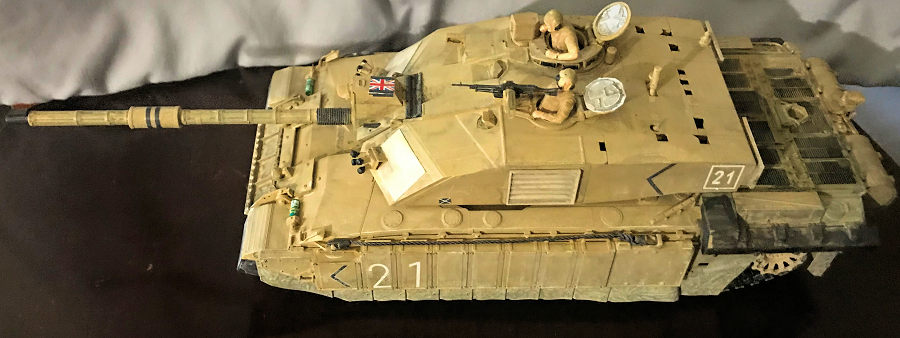
| KIT #: | ? |
| PRICE: | $50.00 |
| DECALS: | Four options |
| REVIEWER: | Donald Zhou |
| NOTES: | Extremely detailed, simple to build, nice fit Disadvantages: details somewhat over-simplified for the 2010s, acetate plate for view ports, lower hull parts from early 80’s |

| HISTORY |
The tank that became the British Challenger II was developed from the original Challenger I by the Vickers Defense Systems, now BAE Land Systems & Armaments. Currently, the UK and Kingdom of Oman operate the tank. It’s a heavily remodified version of the original Challenger I developed in the early 80’s.
The original Challenger I was
built as a result of a
Royal Iranian request to replace their own Chieftain tanks using the then latest
Chobham armor. Unfortunately, before the “Chally I” was fully developed, Iran
fell under the Islamic Revolution and the order was shelved. By late 70’s, the
British Ministry of Defense decided to adapt the new vehicle to supplement and
replace the aging Chieftain. However, the tank, although features the new
Chobham armor and a new rifled barrel 120mm main cannon, was still behind the
brand new German Leopard II and the American M1 Abrams in terms of new digital
computers and sighting units. During 1991 Gulf War, one Challenge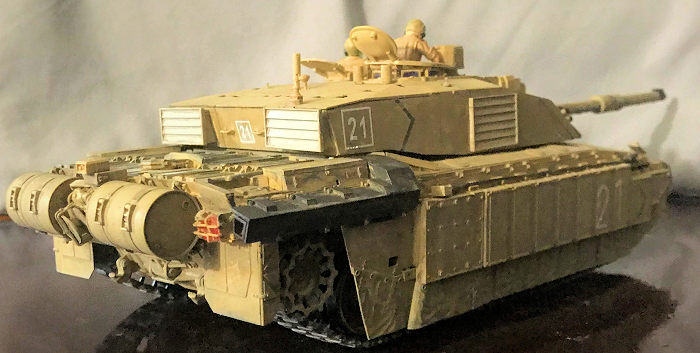 r was able to
destroy an Iraqi T-55 at the range of 4.5 kilometers! Still a record for a tank
kill at long distance. However, after the Gulf War, the tank age really started
to show, especially its aging stabilization and fire control systems against the
new Leopard II A5 and the M1A2 Abrams. During one contests in which a Leopard
II, a M1A1 Abrams and a Challenger were pitted against each other in a firing
course featuring 12 targets, many of them moving with the tank crew required to
execute the target in a set time limit, many of the time limit tight so the
tanks also had to fire on the move, the M1A1 scored a perfect 12/12, the Leo
11/12, and that was mainly because the gunner screwed the firing solution (and
supposedly, he knew it too!), the Challenger? Only 7/12…..About as accurate as a
T-80, all misses especially were against moving targets or targets that were
moving and required the tank to also fire on the move. Something must be done to
improve the vehicle.
r was able to
destroy an Iraqi T-55 at the range of 4.5 kilometers! Still a record for a tank
kill at long distance. However, after the Gulf War, the tank age really started
to show, especially its aging stabilization and fire control systems against the
new Leopard II A5 and the M1A2 Abrams. During one contests in which a Leopard
II, a M1A1 Abrams and a Challenger were pitted against each other in a firing
course featuring 12 targets, many of them moving with the tank crew required to
execute the target in a set time limit, many of the time limit tight so the
tanks also had to fire on the move, the M1A1 scored a perfect 12/12, the Leo
11/12, and that was mainly because the gunner screwed the firing solution (and
supposedly, he knew it too!), the Challenger? Only 7/12…..About as accurate as a
T-80, all misses especially were against moving targets or targets that were
moving and required the tank to also fire on the move. Something must be done to
improve the vehicle.
In fact, the British knew that the Chally I’s firing control and ballistic computers were way long in the tooth and need some vast improvement. To this end, in 1993, they produced the first new vehicle. The Challenger II, or Chally II features the Chobham II armor in a new turret called the Burlington. The hull was similar to the Chally I but also vastly improved and can accept frontal ERA and side armor panels. The torsion bar suspension was also improved to accept the new weight of the vehicle, which is the heaviest of all Western MBT’s due to the heavy armor. A vastly improved TOGS, or Thermal Observation and Gunnery Sight, or TOGS II was moved from the left side of the turret, which heavily restricted its view to a centrally mounted point right above the barrel in front of the turret. An independent thermal viewer similar to the M1A2 Abrams CITV was mounted directly in front of the commander’s hatch. The biggest improvement though was the digital fire control computer from Computing Devices Co of Canada that contains two 32-bit processors with a MIL STD1553B data bus, and has the capacity for additional systems, such as a Battlefield Information Control System. This system, plus an improved gyroscopic stabilizer system for the main gun, brought the tank to parity with the M1A2 and the Leopard 5, and in some cases, better than the baseline A2 Abrams and the Leo 5. Currently, this system is being improved to bring the Chally II to parity with the new M1A2 SEP II and Leo A6/A7.
The tank is armed with the same L55 caliber main 120mm rifled cannon as in the Chally 1, with two machine guns, one co-axle with the main cannon, and one on the loader station. Four men, a commander, driver, loader and gunner rounds out the crew.
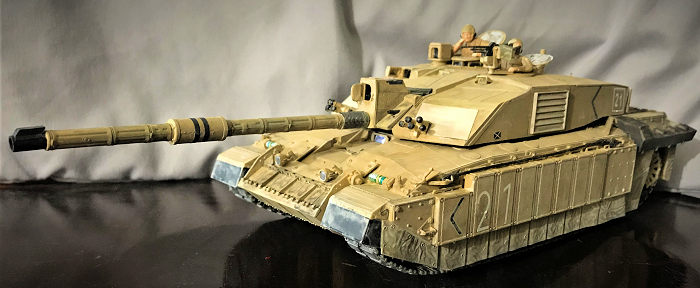 The new tank’s baptism of fire came in 2003 second Gulf War. Previously, the
tank saw service in Bosnia and other peace keeping duties. In order to deal with
the obnoxious sand and dry weather of the desert, several improvements and
changes were added, these included adding long muffler pipes to suppress the
exhaust. A canvas skirt were added to the bottom of the side skirt to reduce
dust from bouncing upward and a series of ERA armored blocks were added to the
hull front and the side skirts. These are the same as the one found on Chally I
in the first Gulf War. Later on, when these EAR blocks proved unable to stop
rockets such as the RPG-29, Burlington armor blocks were used instead.
The new tank’s baptism of fire came in 2003 second Gulf War. Previously, the
tank saw service in Bosnia and other peace keeping duties. In order to deal with
the obnoxious sand and dry weather of the desert, several improvements and
changes were added, these included adding long muffler pipes to suppress the
exhaust. A canvas skirt were added to the bottom of the side skirt to reduce
dust from bouncing upward and a series of ERA armored blocks were added to the
hull front and the side skirts. These are the same as the one found on Chally I
in the first Gulf War. Later on, when these EAR blocks proved unable to stop
rockets such as the RPG-29, Burlington armor blocks were used instead.
Overall, the tank gave great performance. Only two were damaged and one being a completely loss due to a friendly fire incident. The tank will remain service in with the British and Oman for the foreseeable future.
| THE KIT |
Visit this link to see my preview of this kit. To put it simply, everything I said in the kit still rings true. This kit is simple, easy to build if you follow the radical act of following the instructions and plan slightly ahead as the painting can be tricky since this tank has the side skirts canvas covers.
| CONSTRUCTION |
The construction begins with the hull. Now, as stated in the preview, the
hull is basically the hull from the Challenger I released back in 1983 I think.
However, Tamiya did plug up the battery power holes on the bottom and improved
the details. In the end, the details on the side are wasted since when the
sideskirts with the canvas covers are on, it covers up everything except maybe
the very bottom of the road wheels. The road wheels assembly are easy. Poly caps
are used to make sure they are rotatable afterwards. Afterwa rds, I gave the side
a spray of Testor British Army Light Stone, which is a very close match for the
colors used by the British through both Gulf Wars. Then the side skirts with the
canvas boots were put on followed with the tracks. You don’t need to worry about
weathering here cause again, except the drive sprockets and maybe the last road
wheel, the rest are all covered up. Overall, with these easy to build Tamiya
tanks, the major tip is just to take your time, followed the well written and
drawn out instructions and you should have no problem with it. I left off the
green fire extinguishers, the tow ropes, and some of the rear plate parts cause
they are either a different color or clear.
rds, I gave the side
a spray of Testor British Army Light Stone, which is a very close match for the
colors used by the British through both Gulf Wars. Then the side skirts with the
canvas boots were put on followed with the tracks. You don’t need to worry about
weathering here cause again, except the drive sprockets and maybe the last road
wheel, the rest are all covered up. Overall, with these easy to build Tamiya
tanks, the major tip is just to take your time, followed the well written and
drawn out instructions and you should have no problem with it. I left off the
green fire extinguishers, the tow ropes, and some of the rear plate parts cause
they are either a different color or clear.
The turret is slightly more complex. The main cannon barrel is in two halves as slide-mold technology was not invented at that time, it is inserted into the main gun housing with two poly caps trapped in between so the barrel will move. Then the TOGS II is assembled on top of this with a clear piece so take your time to get this right. Also, notice a vinyl piece is included. This is the top cover. Since the top of the turret has many vision devices and clear, with the commander cupola, I sprayed these all with British Light Stone before cutting up the acetate plate and inserting the correct clear parts into place, painted candy purple on the inside. Then the vinyl piece is superglued into place. The rest of the turret is simpler. Be sure to drill out the holes needed to put in the side and rear CIP panels. Keep the hatches open if you want to install the commander and loader figures. With the major assemblies done, time to hit the paint shop.
| COLORS & MARKINGS |
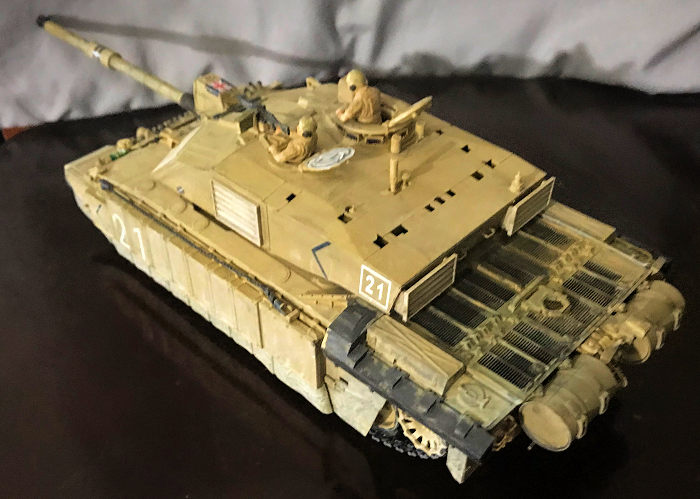 Painting starts with my usual jet black and Tamiya flat black, heavily
diluted and then slobbered on, especially heavily in the rear engine panels.
This is overall sprayed with, again, Testor British Army Light Stone. After the
first coat is dried, more diluted black were brushed on before a third coat is
blasted. If you read any of my armor build, you should know how this goes by
now. The only exception are the canvas boot covers, which were sprayed with Dark
Yellow instead. Decals were put on after the first British Light Stone were put
on. I chose the first option.
Painting starts with my usual jet black and Tamiya flat black, heavily
diluted and then slobbered on, especially heavily in the rear engine panels.
This is overall sprayed with, again, Testor British Army Light Stone. After the
first coat is dried, more diluted black were brushed on before a third coat is
blasted. If you read any of my armor build, you should know how this goes by
now. The only exception are the canvas boot covers, which were sprayed with Dark
Yellow instead. Decals were put on after the first British Light Stone were put
on. I chose the first option.
Weathering is very similar to my M1A2 build (Hey Scott, where did that review go anyways? I can google it, but it’s not in the menu). Namely, I used acrylic cream to simulate the sand dust and peach as an off set. These were slobbered on to the canvas boots especially. Overall, it should create a dusty and battle worn tank. Testor Metalizer Burnt Metal and acrylic burnt umber were used to on the exhaust pipes to simulate the heat in this area.
| FINAL CONSTRUCTION |
Finally, all the tools and accessories were added. These include the antenna,
wind sensor, smoke dischargers, tow cables, which includes the nylon wiring to
simulate the cables themselves and the muzzle. I also used green to color the
front fire extinguishers and be especially careful with the two rear view
mirrors. I left them o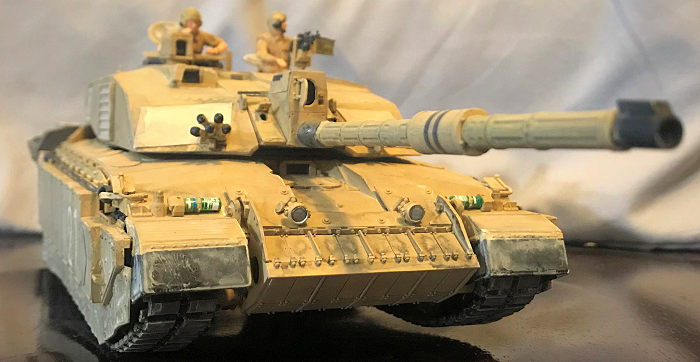 ff till now since well, just take a look at the mirror
supports….They are so thin I thought they will break just by looking at them!
Luckily, they lay flat against the hull. Some will use brass or copper wires to
replace them but I just used the kits parts. These were carefully cut off, then
put on the mirror before superglued to the correct place.
ff till now since well, just take a look at the mirror
supports….They are so thin I thought they will break just by looking at them!
Luckily, they lay flat against the hull. Some will use brass or copper wires to
replace them but I just used the kits parts. These were carefully cut off, then
put on the mirror before superglued to the correct place.
The final pieces are the crew figures. Both are easily assembled. The commander and loader are painting in overall British Light Stone, with Flat Earth as highlights although due to the lighting, you may not see the flat earth too well. Tamiya Flesh were used for the faces and exposed arms with black mic and earphones. Then, finally, use the contained plasticard, and cut out the front CIP. I took the relevant page to the printer and copied the page itself since I do not want to cut up the instructions. Then the paper that contain the CIP was cut off, put on the plasticard, I used a pencil to draw out the outline before carefully cutting them off and put on the tank. These, along with the side and rear “venetian” blind style CIP are all painted in Testor’s Sand and then weathered accordingly.
| CONCLUSIONS |
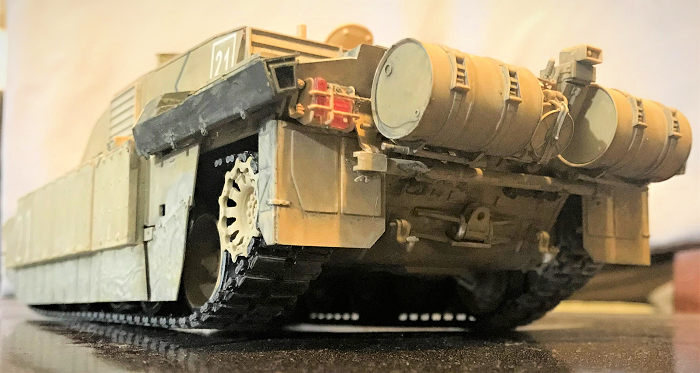 These Tamiya kits are just piece of cake to build. The only thing that
will take some time will be the painting and weathering. They are great practice
for those who just got a few snap kits under the belt and need a harder
challenge or those who just came off of an agonizing hard build or a long slog
and need something far far easier and more relaxing. These kits are certainly
that. They are fun, fit well, not a whole lot of parts and just fall together.
Then you can practice all sorts of weathering technique on them and they all
will turn out looking nice since, hey, they are tanks, and tanks are dirty
things and no weathering will look wrong on them!
These Tamiya kits are just piece of cake to build. The only thing that
will take some time will be the painting and weathering. They are great practice
for those who just got a few snap kits under the belt and need a harder
challenge or those who just came off of an agonizing hard build or a long slog
and need something far far easier and more relaxing. These kits are certainly
that. They are fun, fit well, not a whole lot of parts and just fall together.
Then you can practice all sorts of weathering technique on them and they all
will turn out looking nice since, hey, they are tanks, and tanks are dirty
things and no weathering will look wrong on them!
18 February 2019
Copyright ModelingMadness.com.
Thanks to
for the review kit. You can find this kit at your favorite hobby shop or on-line
retailer. If you would like your product reviewed fairly and
fairly quickly, please
contact
the editor or see other details in the
Note to
Contributors. Back to the Main Page
Back to the Review
Index Page
Back to the Previews Index Page